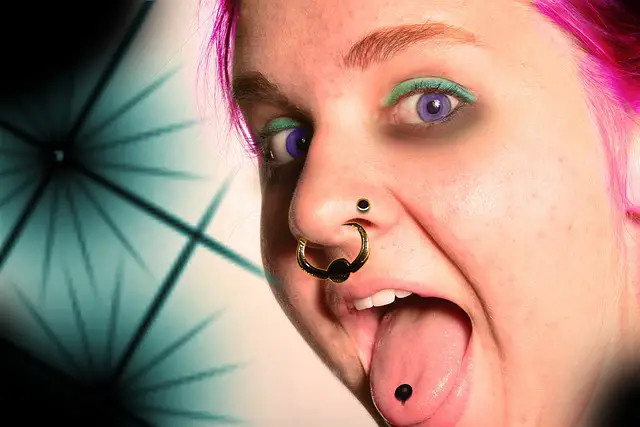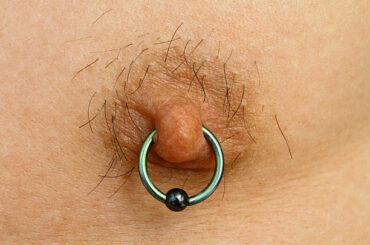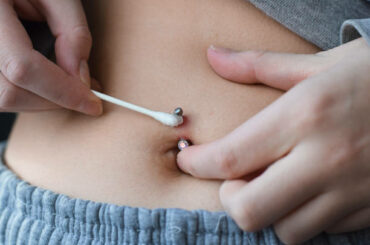Keloid scars are a common concern for individuals who have undergone nose piercings. These raised, thickened scars can mar the appearance of an otherwise stylish accessory. In search of solutions, some have turned to unconventional remedies, one of which is the use of toothpaste. In this article, we will delve into the world of keloid scars resulting from nose piercings, explore the notion of toothpaste as a potential remedy, and ultimately aim to provide clarity on whether this household item holds any promise for managing these bothersome scars.
Contents
Understanding Keloid Scars
Defining Keloid Scars and Their Formation

Keloid scars are an intriguing but often unwelcome phenomenon in the realm of wound healing. They are a type of abnormal scar tissue characterized by their raised, thickened, and often bulbous appearance. Unlike typical scars, which tend to fade and become less noticeable over time, keloids exhibit an overproduction of collagen—a protein that gives skin its structure and elasticity. This excessive collagen production leads to the formation of a keloid, which can extend beyond the boundaries of the original wound.
Keloids typically develop when the body’s natural healing process goes awry. While the exact mechanisms are not fully understood, it is believed that genetic factors play a significant role. Some individuals are genetically predisposed to forming keloids, making them more susceptible to this type of scarring.
Common Occurrence in Nose Piercing Wounds
One area where keloid scars frequently make an appearance is around nose piercings. Nose piercings, while a popular form of self-expression, involve the puncturing of the delicate nasal tissue, creating a wound that the body needs to heal. In some cases, this healing process can take an unusual turn, leading to the formation of keloid scars.
The nose is particularly susceptible to keloid formation due to its high blood supply and the presence of cartilage. The increased blood flow to the area can contribute to collagen overproduction, while the cartilage’s rigid structure may exacerbate the development of keloids by limiting the skin’s ability to contract and heal normally.

Characteristics and Potential Discomfort
Keloid scars, whether resulting from nose piercings or other injuries, exhibit distinct characteristics. They often appear as raised, reddish, or purplish lumps on the skin’s surface, and their texture can range from smooth to rough. Keloids can be itchy, painful, or tender to the touch, causing discomfort and irritation to those who have them.
The cosmetic aspect of keloid scars can also be distressing, especially when they form on visible areas like the nose. Their prominence may affect an individual’s self-esteem and confidence, prompting the search for remedies to manage or diminish their appearance.
In the following sections, we will delve into one such remedy: the use of toothpaste on keloid scars from nose piercings. While this method has garnered attention as a potential solution, it is essential to scrutinize its efficacy and potential risks.
The Toothpaste Myth
Discussing the Belief in Toothpaste as a Keloid Remedy
The belief that toothpaste can effectively treat keloid scars has circulated within various online communities and home remedy enthusiasts. It’s a tantalizing idea: a common household item that can potentially alleviate the discomfort and aesthetic concerns associated with these raised scars. However, before delving into the merits of this belief, it’s crucial to understand the reasoning behind it and the stark lack of scientific validation.

Explaining the Reasoning Behind This Home Remedy
The idea of using toothpaste on keloid scars is rooted in the perception of toothpaste as a multipurpose product. Proponents of this method suggest that toothpaste, containing ingredients like baking soda, fluoride, and mild abrasives, can serve as an exfoliant or a skin-drying agent. In theory, these properties could contribute to the reduction of keloid scars by gently removing the top layer of skin or by drying out the tissue.
Additionally, some individuals claim that the menthol or peppermint oil found in toothpaste may have a cooling and soothing effect on the keloid, potentially alleviating itching or discomfort associated with these scars.
Mentioning the Lack of Scientific Evidence
While the idea of using toothpaste as a remedy for keloid scars may seem plausible on the surface, it is essential to emphasize the dearth of scientific evidence supporting this approach. Keloids are complex skin conditions influenced by genetic, immunological, and wound-healing factors. Effective treatment typically requires a medically validated approach.
To date, no well-designed clinical studies or medical consensus support the use of toothpaste as a keloid treatment. Moreover, toothpaste ingredients are primarily formulated for oral hygiene and not to manage skin conditions. Consequently, the potential risks and ineffectiveness of this home remedy should not be overlooked.
In the following sections, we will delve deeper into these risks and explore the alternative treatments and strategies recommended by medical professionals for managing keloid scars resulting from nose piercings. It is essential to approach the treatment of keloids with a focus on scientifically validated methods to ensure both safety and efficacy.
Ingredients in Toothpaste
Toothpaste is a staple of daily oral hygiene routines, designed to maintain dental health and promote oral cleanliness. It contains a variety of ingredients, each serving a specific purpose in the realm of oral care. It is essential to recognize that these ingredients are primarily intended for oral use, and their application on skin or scar tissue, such as keloids resulting from nose piercings, is not supported by scientific evidence.
List of Common Ingredients in Toothpaste:
Fluoride: Fluoride is one of the most essential components of toothpaste. Its primary role is to help strengthen tooth enamel and protect against tooth decay by demineralizing weak areas.
Abrasives: Toothpaste typically includes mild abrasives like calcium carbonate or silica to help remove plaque, stains, and food particles from the teeth’ surfaces.
Detergents (Surfactants): Surfactants like sodium lauryl sulfate create the foaming action of toothpaste, aiding in the even distribution of toothpaste and helping to dislodge debris from the teeth.
Humectants: Ingredients like glycerin and sorbitol are humectants that retain moisture within the toothpaste to maintain its consistency and prevent it from drying out.
Flavoring Agents: Various flavorings, such as mint or fruit extracts, are added to toothpaste to improve taste and encourage regular use.
Thickening Agents: To give toothpaste its texture, thickening agents like cellulose gum or carrageenan are included.
Preservatives: Preservatives like parabens are used to prolong the shelf life of toothpaste by preventing bacterial growth.

Intended Purposes of These Ingredients:
Abrasives aid in cleaning and polishing the teeth, removing surface stains.
Detergents (Surfactants) create foam, making it easier to distribute the toothpaste throughout the mouth.
Humectants maintain toothpaste consistency and prevent it from drying out.
Flavoring Agents improve the taste and overall experience of brushing.
Thickening Agents provide the toothpaste with a suitable texture for application.
Preservatives extend the product’s shelf life, ensuring it remains safe for use over time.
Emphasizing Toothpaste Ingredients for Oral Care:
It is crucial to emphasize that the ingredients in toothpaste are carefully formulated to address specific oral health needs. They are not intended or scientifically proven to be effective in treating skin conditions like keloid scars. The composition and action of toothpaste are optimized for oral hygiene and should not be used as a substitute for medically approved treatments for keloids or other skin issues.
In the subsequent sections, we will explore the potential risks and ineffectiveness of using toothpaste on keloid scars from nose piercings and highlight the importance of consulting healthcare professionals for appropriate treatments.
The Risks of Using Toothpaste
Discussing the potential risks and drawbacks of applying toothpaste to keloid scars
While the idea of using toothpaste as a remedy for keloid scars may be appealing due to its accessibility, it’s essential to consider the potential risks and drawbacks associated with this unconventional approach.
Possible Skin Irritation and Allergies
One of the foremost concerns when applying toothpaste to keloid scars is the risk of skin irritation or allergic reactions. Toothpaste contains a combination of ingredients, including abrasives, flavorings, and detergents, which are primarily designed for oral use. When applied to the delicate skin around a keloid scar, these ingredients can lead to redness, burning, itching, or other forms of irritation. Individuals with sensitive skin or allergies may be particularly vulnerable to these adverse effects.
Worsening of the Condition
In some cases, the application of toothpaste may exacerbate the keloid’s appearance or lead to unintended consequences. For instance, the abrasive nature of toothpaste could potentially damage the surrounding healthy skin, creating new issues or making the scar more prominent. Additionally, if the toothpaste causes skin dryness or flakiness, it may accentuate the keloid’s texture, making it more noticeable.
Stressing the Importance of Caution
Given the lack of scientific evidence supporting the use of toothpaste as a keloid treatment and the potential risks involved, it is crucial to exercise caution when considering such home remedies. Keloid scars can be challenging to manage, and while the desire for a simple, cost-effective solution is understandable, experimentation with unproven methods can lead to disappointment and worsened conditions.
The discomfort and self-consciousness associated with keloid scars from nose piercings can be distressing, but seeking professional advice and treatments from qualified healthcare providers or dermatologists remains the safest and most effective approach. These medical experts can assess the individual characteristics of the keloid, recommend evidence-based treatments, and monitor progress to ensure the best possible outcome.
In the subsequent sections, we will explore alternative, scientifically validated treatments for keloid scars and emphasize the importance of consulting a healthcare professional for proper guidance and care.
Effective Keloid Treatment
Describing Various Medically Approved Treatments for Keloid Scars
Keloid scars are complex and challenging to manage, often requiring professional medical intervention. Here, we will explore several medically approved treatments for keloid scars and discuss their respective benefits and limitations.
1. Silicone Gel or Sheets:
Benefits: Silicone products can help flatten and soften keloid scars over time by hydrating the skin and regulating collagen production.
Limitations: Consistency and patience are required as results may take several months to become noticeable.
2. Corticosteroid Injections:
Benefits: Dermatologists can administer corticosteroids directly into the keloid, reducing inflammation and shrinking the scar.
Limitations: Multiple injections may be necessary, and there is a risk of skin thinning or discoloration with prolonged use.
3. Pressure Dressings:
Benefits: Special dressings or tapes can exert constant pressure on the keloid, potentially flattening it.
Limitations: Dressings must be worn consistently, and results may vary from person to person.
4. Cryotherapy:
Benefits: Cryotherapy involves freezing the keloid with liquid nitrogen, which can help shrink the scar.
Limitations: It may cause skin discoloration or temporary numbness, and keloids may return in some cases.
5. Laser Therapy:
Benefits: Laser treatment can reduce the size and appearance of keloids by targeting excess collagen.
Limitations: Multiple sessions may be needed, and results can vary depending on the keloid’s size and location.
6. Surgical Removal:
Benefits: Surgical excision may be an option for certain keloids, particularly when combined with other treatments.
Limitations: There is a risk of keloid recurrence after surgery, and it may be necessary to follow up with other treatments.
Highlighting the Importance of Consulting a Healthcare Professional for Guidance
Effective treatment for keloid scars is not one-size-fits-all, and the choice of treatment should be tailored to the individual characteristics of the scar, including its size, location, and the patient’s medical history. Furthermore, some treatments may be more appropriate for certain types of keloids than others.
Consulting a healthcare professional, such as a dermatologist or plastic surgeon, is crucial for several reasons:
Accurate Assessment: Healthcare professionals can accurately assess the keloid and recommend the most suitable treatment options based on its specific characteristics.
Safety: Professional guidance ensures that treatments are administered safely and monitored for any adverse effects.
Optimal Results: Medical experts can combine different treatments or techniques to achieve the best possible results, such as using corticosteroid injections in combination with silicone sheets.
Long-term Management: Keloids may require ongoing management, and healthcare professionals can guide on maintaining results and addressing any potential recurrence.
In conclusion, while the use of toothpaste on keloid scars from nose piercings may be tempting, it lacks scientific support and carries potential risks. To effectively manage keloid scars, it is essential to consult a healthcare professional who can provide evidence-based treatments tailored to individual needs. Seeking professional guidance ensures the safest and most effective approach to keloid scar management.

Conclusion
In summary, keloid scars resulting from nose piercings are a common concern, often prompting individuals to explore unconventional remedies like toothpaste. However, it is essential to approach such treatments with caution and consideration of the available evidence.
Throughout this article, we have explored the following key points:
Keloid scars are raised, thickened areas of scar tissue that can develop at the site of nose piercings, causing potential discomfort and cosmetic concerns.
The notion of using toothpaste as a remedy for keloid scars is rooted in the belief that its ingredients, such as mild abrasives and menthol, may aid in scar reduction. However, this home remedy lacks scientific support.
Toothpaste ingredients are primarily designed for oral care and have not been proven effective for managing keloid scars.
Applying toothpaste to keloid scars carries potential risks, including skin irritation, allergies, and the worsening of the condition.
Medically approved treatments for keloid scars, such as silicone products, corticosteroid injections, pressure dressings, cryotherapy, laser therapy, and surgical removal, offer more reliable and evidence-based options.
In conclusion, toothpaste is not a scientifically supported or recommended treatment for keloid scars from nose piercings. To effectively manage keloid scars and minimize discomfort and visibility, it is crucial to seek professional advice from healthcare experts, such as dermatologists or plastic surgeons. These professionals can provide tailored treatment plans and ensure the safest and most effective approach to keloid scar management. Your skin’s health and appearance deserve the expertise and care that only qualified professionals can provide.





